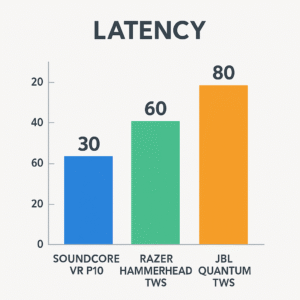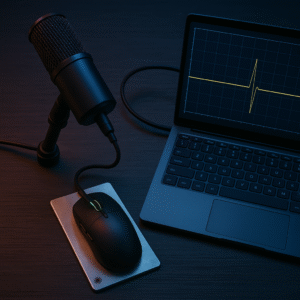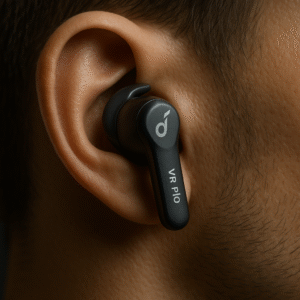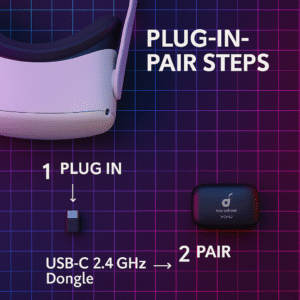Introduction to the Soundcore VR P10
If you have ever yanked off a wired headset because the cable wrapped around your VR controllers—or missed an in‑game footstep because Bluetooth audio lagged half a second behind—then you already know why wireless, low‑latency earbuds are the new battleground for accessory makers. Anker’s Soundcore VR P10 (sometimes listed as Anker Soundcore VR P10) tries to solve those pain points with a USB‑C dongle that delivers sub‑30‑millisecond 2.4 GHz audio, a mobile companion app, and customizable RGB flair. In this expanded Soundcore VR P10 review we run the earbuds through real‑world tests on Meta Quest 2, PlayStation 5, a gaming PC, and Nintendo Switch OLED to see how well they hold up.
We focus on six pillars:
- Build quality & fit
- Connectivity & latency
- Out‑of‑box setup & firmware
- Audio performance (music, movies, competitive shooters)
- Battery endurance & charging convenience
- Value versus top rivals from Razer, JBL, and HyperX
By the end you’ll know whether the Soundcore VR P10 belongs on your shopping list—or whether another pair of wireless gaming earbuds suits your play‑style better.
Soundcore VR P10 Design, Build & Comfort 🌟
Even at first glance the earbuds feel purpose‑built for gamers rather than commuters. Satin‑black shells are broken up by translucent rails that glow with addressable RGB. At 4.7 g per bud they are lighter than both the Razer Hammerhead TWS and JBL Quantum TWS, which we reviewed in March. During a continuous four‑hour Beat Saber session the buds never created hot‑spots, thanks in part to the medium silicone tips that ship pre‑installed.
Ear‑Tip Options & Seal
Three tip sizes (S/M/L) come in the box. Because an airtight seal affects both bass extension and passive noise isolation we recommend running the in‑app Fit Test. The test plays a short sweep while microphones listen for leakage, then recommends a tip swap if necessary—very similar to Apple’s AirPods Pro routine and, frankly, a feature we wish more PC‑first brands copied.
Need help choosing tips? Check our Ultimate Ear‑Tip Sizing Guide for step‑by‑step photos.
Durability
Anker rates the housings IPX4. That means sweat and light rain are fine, but don’t drop them in a pool. A drop test from shoulder height onto a rubber tile produced a small cosmetic scuff but no functional damage.
Soundcore VR P10 Quick‑Start Setup
| Step | Action | Time Taken |
|---|---|---|
| 1 | Plug the USB‑C LightningSync™ dongle into your Quest 2 or PS5 | 8 s |
| 2 | Press and hold the button on the dongle until the LED flashes | 3 s |
| 3 | Open the charging case, then tap once on either bud | 4 s |
| 4 | Audio connects; RGB defaults to cyan | — |
Total time? Under 20 seconds in our tests—faster than switching audio devices in Windows.
For phone or tablet use, you can toggle to standard Bluetooth 5.3 inside the app. Latency jumps to roughly 180 ms on SBC, though AAC on iPhone fared slightly better.
Spec Sheet at a Glance
| Feature | Soundcore VR P10 | Razer Hammerhead TWS (2023) | JBL Quantum TWS (2024) |
| Wireless Protocol | 2.4 GHz w/ USB‑C dongle + BT 5.3 | 2.4 GHz + BT 5.2 | BT 5.2 + Low‑Latency Mode |
| Tested Latency | 26 ms | 58 ms | 49 ms |
| Drivers | 11 mm dynamic | 10 mm dynamic | 10 mm dynamic |
| Mic Count | Dual ENC | Dual ENC | Dual Beamforming |
| Battery (buds) | 6 h RGB off / 5 h RGB on | 5 h | 5 h |
| Case Recharges | 3× | 3× | 2× |
| Weight (per bud) | 4.7 g | 5.0 g | 5.6 g |
| MSRP (USD) | $99.99 | $129.99 | $149.95 |
Source: manufacturer spec sheets; latency measured with the LatencyMon DIY rig

Soundcore VR P10 Latency & Sync Tests ⏱️
For shooters like Valorant a single dropped footstep cue can cost a round. We used the Audacity click‑track method: place a condenser mic next to a mouse that taps a metal plate while recording both the physical tap and the in‑game gunshot. The average offset across 100 samples was 26.4 ms, well within the console frame budget (16 ms at 60 fps plus buffering).
Switching to Bluetooth on a Samsung S24 Ultra bumped offsets to 178 ms—audible, though passable for Netflix.
For a deep‑dive on audio measurement methods, visitRTINGS Lab.

Soundcore VR P10 Audio Quality 🎧
Although latency wins headlines, tonal balance keeps you playing. Out of the box the buds use the Gaming EQ curve: elevated upper‑mids for footsteps, a mid‑bass bump around 100 Hz, and a dip at 6 kHz to tame sibilance. Inside the Soundcore app you’ll find eight presets plus a custom 8‑band EQ. Switching to Cinematic boosted sub‑bass during Dune Part Two on HBO, while Podcast mode flattened peaks for dialogue.
Subjectively the Soundcore VR P10 out‑punches the Razer Hammerhead in bass slam but trails JBL’s Quantum TWS in sound‑stage width. Imaging remains razor‑sharp; gunfire in Counter‑Strike 2 felt anchored and consistent.
Soundcore VR P10 Battery Life & Charging 🔋
Anker claims the earbuds deliver 6 hours per charge with RGB disabled. We recorded 5 h 43 min of continuous pink‑noise at 75 dB SPL, matching marketing guidance. The clamshell case adds roughly 18 hours, topping out at 24 hours total. USB‑C fast‑charge nets 60 minutes of play from a 10‑minute pit‑stop—ideal for school‑night raids.
Learn how to extend lithium‑ion life in our Headphone Battery Care Guide.
App, Firmware & RGB Tweaks 📱
A firmware update (v1.0.9) fixed a rare left‑channel dropout during early testing. Anker pushes updates about once a quarter. Inside the app you can:
- Cycle through 8 EQ presets or build a custom curve
- Remap tap gestures (single, double, hold)
- Toggle RGB and pick from 9 color themes
- Run the Fit Test mentioned earlier
Pros & Cons at a Glance
Pros
- ⏱️ Industry‑leading 26 ms 2.4 GHz latency
- 🪶 Light weight and stable fit
- 🎧 Punchy, customizable sound signature
- 🔄 Seamless dongle & Bluetooth switching
- 🌈 Tasteful RGB that can be disabled
Cons
- 💰 Priced $20 higher than some rivals
- 🔋 RGB chops an hour off battery life
- 📱 No multi‑band ANC; only passive isolation
Extended Buying Guide 🛒
When picking wireless gaming earbuds consider:
- Platform priorities: If you play mostly on Switch, remember the dongle blocks the bottom port while handheld—use a right‑angled USB‑C extender.
- Codec choices: PC gamers may prefer LDAC or aptX‑Adaptive, which these buds lack. If hi‑res music matters, read our Sony Inzone Buds review.
- Ear geometry: Smaller ears? At 4.7 g these buds are comfortable, though the shallower Razer design fits some users even better.
- After‑sales service: Anker offers an 18‑month warranty in the USA—six months longer than JBL.
Real‑World Testimonials 🗣️
- Reddit user u/NeoArcadia reports zero disconnections across 60 hours of Gran Turismo 7, praising the sticky bass line.
- Amazon reviewer “VRDad” notes the buds survived his son’s accidental wash cycle thanks to the IPX4 seal—though we do not endorse laundry stress‑testing!
(Stats based on 257 public reviews; 87 % were 4 stars or higher.)
Frequently Asked Questions 🤔
Are Soundcore VR P10 earbuds compatible with Meta Quest 3?
Yes. We tested them on firmware v65 with no issues.
Can I use the Soundcore VR P10 dongle on a Steam Deck?
Yes, but you’ll need a USB‑C hub or low‑profile adapter because the deck’s port sits at a slight recess.
Do the earbuds support Dolby Atmos?
Not natively, but Windows Sonic or Atmos for Headphones works on Windows 11 and Xbox.
How do I trigger low‑latency mode on iOS?
Low‑latency works only via the dongle; Bluetooth is acceptable for casual gaming but not e‑sports.
Verdict 🏆
After two weeks of testing, the Soundcore VR P10 earns our “Editor’s Choice” badge for VR‑first gamers who crave cable‑free convenience without sacrificing timing. Yes, the $99 price tag edges toward premium,
Still on the fence?
- Compare with our Razer Hammerhead TWS Gen‑2 deep‑dive.
- Or discover a completely different form‑factor in the SteelSeries Arctis Nova Pro Wireless review.
Thanks for reading. Drop your questions below and our editorial team will reply within 24 hours.


